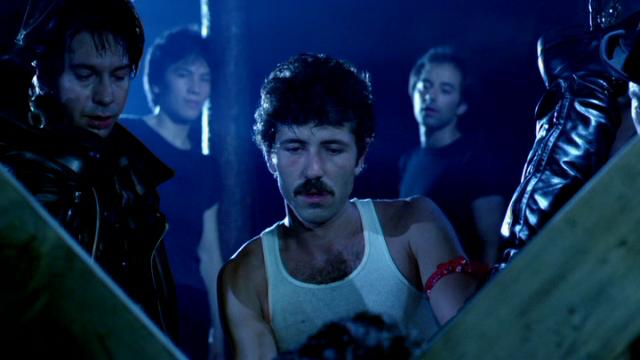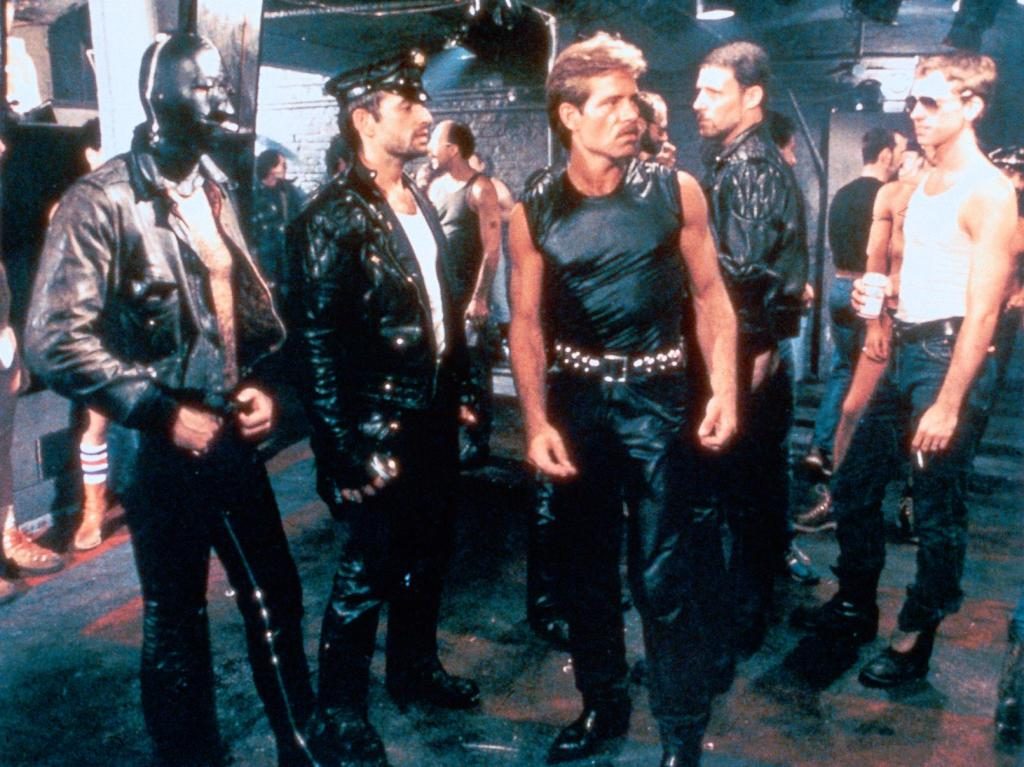Cruising (1980) is a thriller directed and written by William Friedkin, based on a novel by Gerald Walker.
William Friedkin, well known for directing The French Connection and The Exorcist, already had history (not necessarily the good kind) with LGBTQ topics when he directed The Boys in the Band (1970), released only a year after Stonewall. Even before it was made, Cruising was controversial, and gay activists repeatedly interfered with the filming. However, the film also included many patrons of gay leather clubs in the club scenes.

A series of stabbings of gay men involved in the heavy leather/S&M prompts NYPD Captain Edelson to recruit rookie officer Steve Burns (Al Pacino), as he fits the profile of the victims. Steve is to go undercover, infiltrate the leather world, and find the killer. Steve agrees to this (risky and unreliable) plan, hoping for a promotion to detective.
Edelson says to Steve, “Lucas and Vincent [the victims] were not in the mainstream of gay life. They were into heavy leather, S&M. It’s a world unto itself. I don’t know how much you know about that sort of thing.” The theatrical release included a similar disclaimer message. This is a flimsy disclaimer for a film that loves to show the blue-tinted world of leather.
A lot of the middle of Cruising is a travelogue of the leather/S&M culture of NYC, only a few years before AIDS hit. Many of the extras in these scenes were recruited from NYC leather bars. The club scenes were probably unlike anything else ever captured on mainstream film at that time. Reportedly, forty minutes of hardcore gay sex were cut to get this film down to an R rating from an X. Even the few brief moments showing flagellation or alluding to fisting must have been a revelation.

While there’s a lot to criticize about Cruising’s depiction of gays, in fairness the film does depict how queer men are alternately ignored, exploited and brutalized by the NYPD and other powers that be, in ways that are sexualized if not actually sexual. When the higher ups start pressuring for a resolution to the investigation before the Democratic convention, Steve arranges a sting to capture a suspect, Skip, who has been watching him in the clubs.

When a platoon of armed cops storm the hotel room, they find Steve naked and hogtied by the suspect. “What are you doing here?” Steve asks, annoyed.
Maintaining Steve’s cover, he and Skip get interrogated by multiple officers. In the film’s most surreal moment, one of the detectives opens a door in the interrogation room and reveals a tall, muscular, black man, wearing only a jock strap, leather boots and a cowboy hat. This guy walks in, smacks Steve hard enough to knock him out of his chair, and walks out. Does the NYPD keep large, nearly naked black men around to aid in interrogations?

Extracted from the interrogation, Steve objects to the heavy psychological tactics used on himself and Skip, such as threatening him with the “floating ball test”.
Steve: “I didn’t come on this job to shitcan some guy just ‘cause he’s gay, Captain.”
Edelson: “You’re going to come in to days when you have to collar a dozen guys like that. Scared, weird little guys who don’t know why they have to do what they do. It isn’t their fault, it isn’t your fault, it’s the job.”
Steve: “I can’t do the job.”
While Cruising does show gay men from a variety of walks of life, they all end up dead or killers. Even Ted, the friendly playwright who lives down the hall from the apartment Steve uses, and who says he is too scared to go cruising, ends up stabbed to death. The killer’s motivation is ultimately revealed to be a disapproving father.
Or at least that is the surface reading. Cruising is riddled with gaps, elisions and lacunae. By some accounts, the missing forty minutes of footage also included more development of Steve’s character. We are constantly wondering about the protagonist’s sexuality and sanity, what he did after or before we see him. There are plenty of red herrings too. For example, the film starts with severed body parts being found in the river, but it’s not at all clear there’s any connection to the stabbing murders. Men in leatherman outfits are constantly being mistaken for each other.
The killer in Cruising is a vague and amorphous entity, always partially hidden, portrayed by different actors in different scenes, and with dubbed voices. (The influence on the shadowy killer in Tightrope is clear.) This makes the movie less like a police procedural and more like a horror movie, suggesting a kind of contagious evil that moves from susceptible body to body. (Note that Friedkin directed The Exorcist.)
Cruising seems to say that gay sex, and specifically the overheated, drug-infused realm of leather bars and clubs, is seductive and contagious. At the beginning of his mission, Steve is visibly freaking out, asking what hankie codes are for, getting the codes wrong, and getting kicked out of precinct night at the bar for not wearing police gear.
As Steve adapts to his new environment, learning the codes and jargon, his relationship with his girlfriend Nancy (Karen Allen) suffers. Apart from the fact that he can’t tell her where he goes or what he does, their sexual relationship changes. His first visit to her during his assignment involves sex that is more aggressive than before. Is gentle sex no longer enough for him, or has his libido been cranked up by the hypersexual atmosphere, or is he over-performing heterosexuality to manage his self doubt?
Later, he visits her in full cruising gear, key ring jangling from the left side of his belt.
Nancy: “Why don’t you want me anymore?”
Steve: “I’m tired, that’s all.”
Nancy: “I’m not an idiot.”
Steve: “Nance, what I’m doing is affecting me.”
Nancy: “I’m on your side, you know. I don’t understand what’s happening to you.”
Steve: “Neither do I.”
By the end, he’s wearing the leatherman outfit like a second skin and fluently using the scene’s slang. In his final confrontation with the apparent killer, he is far more domineering than his foe. Has he somehow “caught the gay” via exposure, or has his performance revealed something repressed within him? It’s worth noting that we see Steve observing other men, but we rarely see partake.

In the final scene, with the killer apparently caught and his assignment over, Steve returns to his girlfriend’s place, changes clothes and shaves. While he’s in the bathroom, his girlfriend finds his shed leatherman gear and puts on his mirrorshades, cap and jacket. The last images are Steve looking into the mirror, suggesting he has not escaped the underworld, followed by more boats in the river. Even the normative heterosexuality of his relationship with Nancy is not free from the contamination of deviance.
All this ambiguity makes Cruising a Rorshach test. No doubt this fueled homophobia among people who were predisposed for that. I imagine that, in recent decades, some gay men would look at the club scenes of this movie as a nostalgic glimpse of a golden age, post-Stonewall and pre-HIV. If you’re at all kink-friendly, you’re likely to read it as one twisted closet case spoiling it for all the other men who just want to have a good time.

In the end, I don’t think Friedkin had any particular thesis on gays and/or BDSM. It was just an interesting setting for a movie. There’s no investigation of why people do this or letting them speak for themselves. Did Friedkin, in making Cruising, have a duty to make some kind of positive statement about homosexuality and/or sadomasochism? Given the controversy surrounding depictions of non-normative sexuality in mainstream media, today and even moreso in 1980, I think he did.
I would postulate that Cruising is the cinematic progenitor of the “erotic thriller” sub-genre of film, and you can see the resemblance in the previously discussed Videodrome, Tightrope and 8MM, even though they are mainly about heterosexual sex. The two main elements are the “descent into the underworld” structure, and the conflicted protagonist. Even that atrocious adaptation of Exit to Eden (1994) borrowed this structure.




[…] just a standard slasher/megalomaniac with the trapping of BDSM, much like the villains of Cruising, Tightrope and […]
[…] Films (Trips) podcast discusses the thriller film Cruising (1980) (previously discussed), with guest Dr. Brandon Arroyo of the Porno Cultures podcast. Dr. Arroyo talks about how this […]
[…] definitely has some resemblance to Cruising: paranoid people in an urban environment, a serial killer who could be anybody, masculinity in […]
[…] Friedkin, who directed the notorious Cruising (1980), once said in an […]
[…] was ahead of its time regarding sex work and BDSM, years before Cruising (1980) or Eating Raoul (1982). It shows the variety of interests and equipment needed, everything […]
[…] feelings towards the mother that are transferred to the female-presenting therapist. This echoes Cruising (previously discussed) with its killer (or one of them) haunted by his dead, disapproving father. […]
[…] is a 1995 erotic thriller directed by William Friedkin (director of the previously discussed Cruising (1980)), and written by Joe Ezterhaus, who also penned Flashdance (1983) Basic Instinct […]